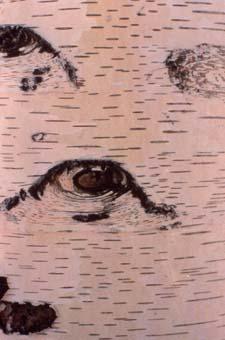Tree
European White Birch
Betula pendula

European White Birch bark
Features
White bark that is only slightly peeling. Fall color is a pale yellow.
Culture
Full sun to partial shade; best in moist, well drained soils; tolerates wet sites.
Cultivars
There are cultivars commercially available, but this species is so poorly adapted to the Midwest and so prone to bronze birch borer that it is not recommended.
Mature Height
40-60 Feet
Size
Medium
Large
Mature Form
Oval, with pendulous branches
Native To:
Northern Europe
USDA Hardiness Zone
3 - 6
Soil Conditions
Moist, Well-Drained
Wet
Tolerance
Wet Sites
Exposure/Light Requirements
Full Sun
Partial Sun/Shade
Uses
Shade
Specimen
Foliage Color
Green
Fall Foliage Color
Green
Yellow
Pests and Problems
Animal Damage
Environmental Damage
Fungal Disease
Insect Damage
Insect Relative Damage
Additional pests and problems that may affect this plant:
Leaf miners and bronze birch borer.
Additional Notes
Best in cold climates; Midwestern summers are too hot and stress the tree leaving it open to the borer
Related Resources
Home, Yard & Garden Pest Guide
The Home, Yard & Garden Pest Guide (C1391) provides is written for homeowners and other residents and provides nonchemical and current chemical recommendations for controlling pests associated with trees, shrubs, turf, flowers, groundcovers, vegetables, fruit, and houses. In addition, you'll find detailed information about integrated pest management, pesticide safety, and pesticide application and calibration techniques. This publication may be purchased at your local University of Illinois Extension Unit office, or by calling 800-345-6087, or by placing an order online (search for "C1391").
Visit site >>
Illinois Commercial Landscape and Turfgrass Pest Management Handbook
The Illinois Commercial Landscape and Turfgrass Pest Management Handbook (ICLT) is written for professional applicators and provides nonchemical and current chemical recommendations as well as application timing information for all major pests of turf, woody ornamentals and herbaceous ornamentals. This publication may be purchased at your local University of Illinois Extension Unit office, or by calling 800-345-6087, or by placing an order online (search for "ICLT").
Visit site >>
U of IL - Distance Diagnosis through Digital Imaging
A free plant, weed, insect and disease identification service available through your local University of Illinois Extension office. Center Educators or State Specialists review & respond to information and digital images submitted by local Extension office personnel. Some samples may require further examination or culture work (nominal fee involved) at the U of IL Plant Clinic.
Visit site >>
U of IL - Plant Clinic
Services include plant and insect identification, diagnosis of disease, insect, weed and chemical injury (chemical injury on field crops only), nematode assays, and help with nutrient related problems, as well as recommendations involving these diagnoses. Microscopic examinations, laboratory culturing, virus assays, and nematode assays are some of the techniques used in the clinic.
Visit site >>
